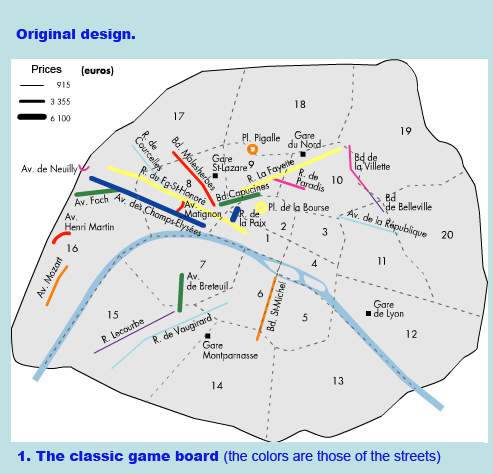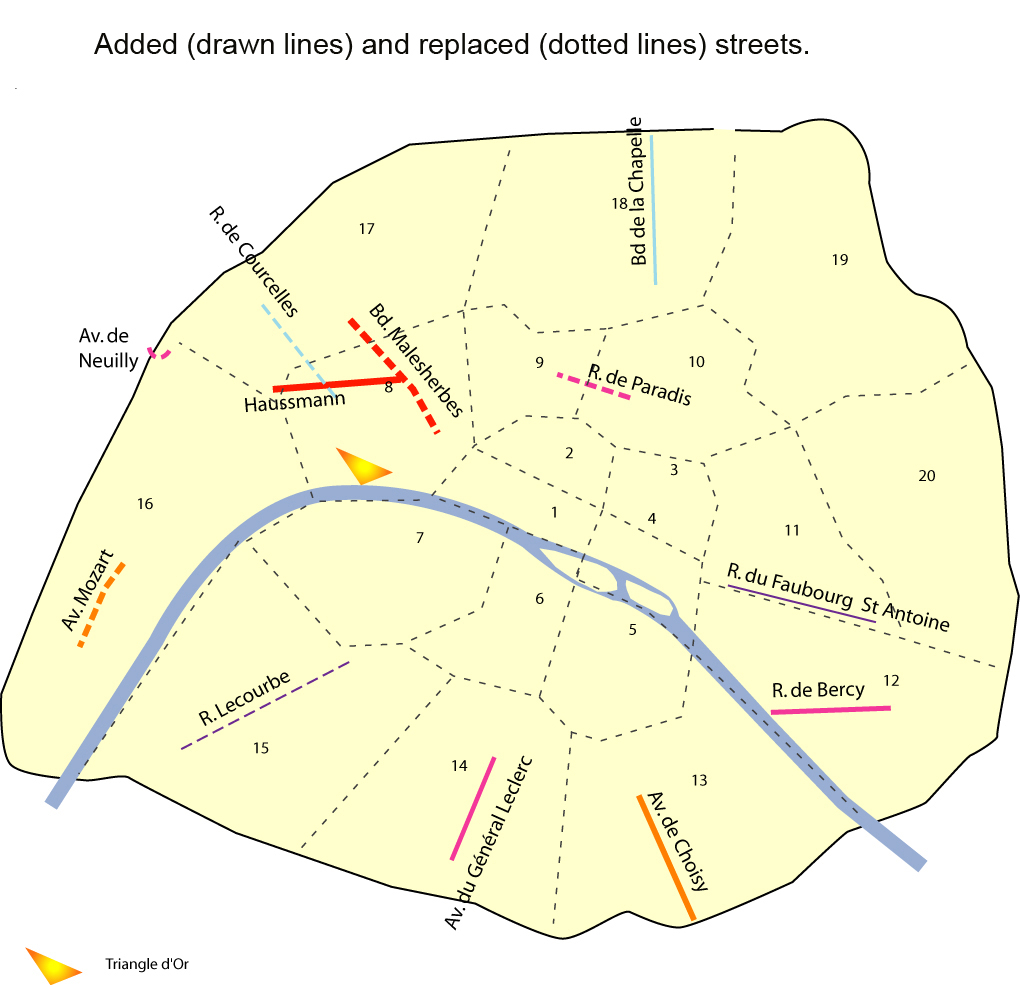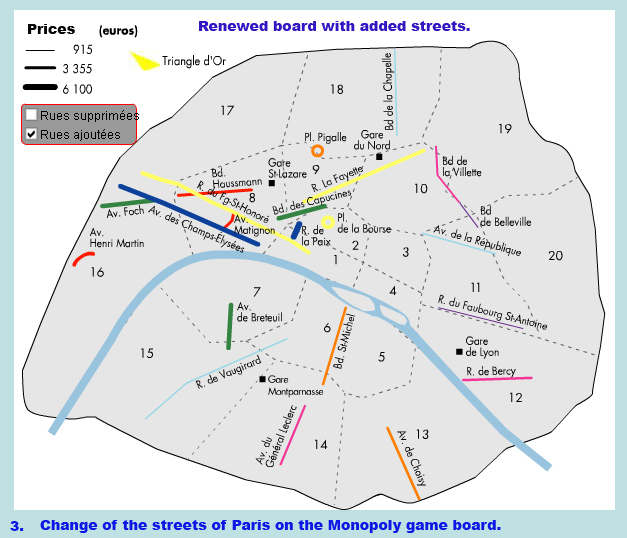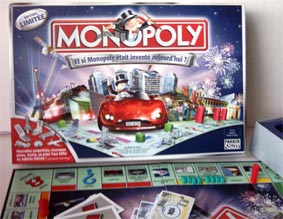|

|
Published: December 21, 2005
|

In the French 3-monthly M@ppemonde,
No.77 (1-2005) the article below was published, in which a proposal to revise
the Paris game board is done.
It happened however that Hasbro in honor of Monopoly's 70th anniversary
in this same year (2005) published the revised edition "Et si Monopoly
était inventé aujoud'hui?" ("And if Monopoly
was invented today?"). I was quite surprised to see the French
Newspaper Libération of Saturday October 8, 2005 published two articles on this
very same topic as well.
So fuss in France and sufficient reason to ask special attention for this!
Febr.2005: "The streets of Paris going from Monopoly,
a proposal for revision"
Marie-Françoise Fleury (Collège Marc Chagall, Gagny - F)
Hervé Théry (Centre Nat. de Recherche Scientifique - F)
The original design
The Paris game board contains 22 avenues, streets or squares, 4 stations, a
water works and an electric company, all concentrated upon the right Seine bank,
as shown by
figure1.
 Only 4 streets and 1
station are situated on the left bank. That choise may have been reasonable,
because the right bank stood for business, luxury and trade, while the left bank
represented culture and education. A preponderance of the right
bank is normal in a game in which enrich oneself is the goal. The northern districts (like the18th and 19th),
eastern (like the 20th)
and the southern part of the capital (like the 13th and 14th)
are not at all represented on the board of this game. There has been no single
street chosen of the isles
Saint-Louis and la Cité, the historical centre of the capital.
Only 4 streets and 1
station are situated on the left bank. That choise may have been reasonable,
because the right bank stood for business, luxury and trade, while the left bank
represented culture and education. A preponderance of the right
bank is normal in a game in which enrich oneself is the goal. The northern districts (like the18th and 19th),
eastern (like the 20th)
and the southern part of the capital (like the 13th and 14th)
are not at all represented on the board of this game. There has been no single
street chosen of the isles
Saint-Louis and la Cité, the historical centre of the capital.
Today an analysis of Paris' real estate prices show another contrast: in the
western part of the capital the prices are much higher than in the eastern one. This
opposes - schematically - a middle-class and official Paris, to an industrial
Paris and polpular Paris, even when now the most eastern districts of Paris
have been renovated. This criterion apparently did not really came up for
discussion for the Paris game board, because there is not really an equal
distribution of the streets from the west and the east, even when the
"better districts" being preferred to the more popular workman's
districts.
So it seems the choice made for of the axes taken is rather based on the history and reputation
of certain districts, as we can see proceeding over the board from the
cheaper streets to the more expensive ones. The Rue de
Belleville is a good example of the contrast of both value systems: it
is one of the cheapest streets of Monopoly and indeed it is a street in
the east part of the capital, preserving the memory of an industrious past.
Since the XIXth century this district lodges countless immigrant
communities like the Jews from Eastern Europe, Armenians,
Spaniards, Greek and North Africans. Today it's the turn of the Azians, mainly
Chinese, to invest in this district.
In reverse, the Rue Lecourbe in the 15th district
is nowadays part of a posh district and should no longer belong to the cheap
streets of the game. This also applies to the Rue de Vaugirard,
almost precisely parallel to the Rue Lecourbe (in addition it is the longest
street of Paris). The Boulevard de la
Villette has lost its popular atmosphere with its bistro's and
slaughterhouses, so well described by Boris Vian, to get his nobility letters,
in his "City of Science and Industry". This very well visited centre
of culture and education symbolizes the revival of eastern Paris, but its place
on the game board looks rational when the game was designed.
On the other hand the Avenue de Neuilly never was a popular district, but
hwas always been part of distinguished districts. The Rue de
Paradis also had its special place, because it is the centre for
cristal and pottery of Paris: Baccarat has here established its Cristal Museum.
Continuing our trip over the game board we arrive at the Boulevard Saint-Michel,
in the middle of Quartier Latin, known by its religious and academic traditions. In
this historic and cultural pre-eminently district this boulevard is well in
place. As far as the Place
Pigalle in the middle of Montmartre is concerned, that is the somewhat
old-fashioned red light district and is visited by an endless stream of tourists mingling with
the local people only 2 steps away from the Moulin Rouge.
The Boulevard Malesherbes, built between 1860 and 1866, causing
the disappearance of Little Poland district, connects Place
Saint-Augustin with Place de la Madeleine and is a good representative of the
Haussmann era, not far away from the business boulevard
bearing the name of the man who was governor of the Seine from1853 till 1870.
The Place de la Bourse owes its fame to the Palais
Brongniart, called after the archtect who started building this palace in 1808 (despite
much later, between 1902 and 1907, 2 wings were added).
Since its foundation the Paris Stock Exchange has been financial meeting point
of France causing a permanent feverish activity despite the famous
"corbeille" (= "basket", here: closed section for stockbrokers)
has been substituted by a computerized quotation.
Already in 1890 the Rue du Faubourg Saint-Honoré saw a
craftsman saddler settling down. His name was Hermès and he was selling armours.
Today it is one of the most luxury and well-known shops in the whole world.
Nowadays this street is a display window of French luxury and fashion: a couple
of renowned names in the high fashion of Paris and abroad have their seats here.
Being a well situated street for the business world, also innumerable antique
shops and juwellers have established in this street. Eventually, this is the
street where the Palais de l'Élysée is situated, the official residence of all
French Presidents since 1871. So today this street ought to be amongst the most
expensive streets of the game board, because of its commercial and political
importance.
The Boulevard des Capucines, according to the model of the large boulevards,
is somewhat different from the earlier district, but it used to be very popular
spot in Paris. It stood for "the Paris' life" and the famous "boulevard
mentality". It is the theatres district, like the Olympia, still being one
of the most important
music-halls.
Finally we arrive at the Champs-Élysées, the large, triomphant avenue in
Paris, connecting the Place de la Concorde, with its famous obelisk, with the Place Charles de Gaulle,
with its not less renowned Arc de Triomphe. It is unquestionable one of the most
important axes of the capital, but to consider it "the most beautiful
avenue of the world" may be an exageration..... It remains in any case one of the most renowned,
but is strangely enough, not the most exspensive one on the game board in
question.
The one who is on top the hierarchy , the Rue de la Paix, is
but hardly known by the majority of the French people: many just know it thanks
to Monopoly, but do they really know why it is supposed to be among the dream districts? It owes its place to the jewellers concentrated in that area.
They were moved during the second Empire, from the Palais-Royal, where
they lived since the Ancien Régime (i.a.before the 1789
Revolution). The
great challenges of that time as well as the eccentricities of the Belle Époque
helped the fast development of this profession. This
symbolic place for international jewelry trade makes unevitably thinking of
things like gold and precious stones. The very greatest, like Cartier, Chamet, Boucheron, Van
Cleef and Arpels are represented on this world axis of richness and luxury.
Proposal for revision
 Between
1935 and 2005 Paris has gone through a strong development in most of its
districts, strengthened by radical changes of real estate values. Fashions have
led to search for privileged places in a certain district while
avoiding other territories. What there is the situation today and what can we propose to keep a
true picture of the game going from the poorest districts to the richest? The
principle we have choosen was to take into account the revaluation after
70 years of the real estate values (resulting in an important change of
contrasts between different parts of the city), all in order to come to a better
representation of the various districts, which is not at all the case in the
original version. The East part of Paris is completely changing fast and we see a
rearrangment of the capital, leading to decrease the differences between East
and West Paris can be seen. Between
1935 and 2005 Paris has gone through a strong development in most of its
districts, strengthened by radical changes of real estate values. Fashions have
led to search for privileged places in a certain district while
avoiding other territories. What there is the situation today and what can we propose to keep a
true picture of the game going from the poorest districts to the richest? The
principle we have choosen was to take into account the revaluation after
70 years of the real estate values (resulting in an important change of
contrasts between different parts of the city), all in order to come to a better
representation of the various districts, which is not at all the case in the
original version. The East part of Paris is completely changing fast and we see a
rearrangment of the capital, leading to decrease the differences between East
and West Paris can be seen.
Nevertheless the first streets and avenues have to be in the North and East of
the capital. It would be interessing to introduce for example the Boulevard Voltaire
or the Rue de Faubourg Saint-Antoine, both connecting the Place de
la République with the Place de la Nation. The suburb Saint-Antoine
is a district with strong artisan traditions, being a centre of industrial and
crafty activities over a long period, but it also was a very populated district
agitated by numerous rebellions in the French Revolution era. Today this
district is notable by its commercial development, and although
there still are crafty cabinet-makers these are largely replaced by furniture
stores along this axis of the capital. This suburb could well substitute the Rue Lecourbe,
too expensive now as far as the price of houses is concerned. In the
North, for the same reason as with the Rue Lecourbe, instead of the Rue de
Courcelles, the Boulevard de la Chapelle can be taken, situated close to the Gare
du Nord and not far away from the Gare de l'Est.
For the intermediate streets of the game board, we ought to keep to the streets situated in the 17th, 12th or 13th district to
get a better distribution of the selected axes. The
Rue de Bercy or the Quai de Bercy of the 12th could be
suitable. This district is the seat of the Ministery of Finance today, close to
the National Library of France and the Palace of Sports
(POPB) of the same name. Because this district is important for financial
affairs as well as for culture and sports this choise would very well illustrate
recent progress of East Paris and so it could replace the Rue de Paradis on the
game board.
 The
Avenue de Neuilly, very expensive and very dignified for its place on the board,
could be replaced by the Avenue du Général Leclerc of the14th
district that was totally forgotten on the original board. Doing so, a hero
from the Second World War, an event that happened only after the
birth of the game, could be honored. The Avenue Mozart
in the 16th district is also too distinguised for this group of
streets. It could disappear in favor of the Avenue de
Choisy, the central axis of Paris' "Chinatown" situated between
the high rise buildings built during the renovation of the13th district,a territory
also forgotten. The
Avenue de Neuilly, very expensive and very dignified for its place on the board,
could be replaced by the Avenue du Général Leclerc of the14th
district that was totally forgotten on the original board. Doing so, a hero
from the Second World War, an event that happened only after the
birth of the game, could be honored. The Avenue Mozart
in the 16th district is also too distinguised for this group of
streets. It could disappear in favor of the Avenue de
Choisy, the central axis of Paris' "Chinatown" situated between
the high rise buildings built during the renovation of the13th district,a territory
also forgotten.
One could consider to honor Georges-Eugène Haussmann, who has
considerably changed Paris putting on the board the boulevard bearing his name (in the Opéra district) instead of the Boulevard Malesherbes. Today this
boulevard is the one of the "big department stores" on the right
bank, like the Printemps (nr.64) and the Galeries Lafayette (nr.40). These more
than well-known buildings are a must on the programme of millions of
tourists and potential buyers. They are almost looked at as historical monuments.
It seems almost impossible to erase the Champs-Élysées and the Rue de la Paix
from the board, and one could leave them on the board as «blue» streets and,
in the «green» streets, instead of the Avenue de Breteuil, the Avenue Foch and the Boulevard des
Capucines
add the Avenue Montaigne, the Avenue
George V and the Rue François I, the most important axes of the "Triangle d'or" (the
gold triangle), important business centres, luxury and studios of great
fashion designers.
The objective of this modest proposal is only to let the Monopoly game board be
a more true image of nowadays Paris and it not at all intends to change the
game, although it is intense and shamelessly capitalistic. But the one who
never enjoyed the sadistic pleasure ruining an opponent who was brought by the
dice to "his" Rue de la
Paix (with hotel) throw the first stone ...
-o-
Color of the
streets |
Classic
Monopoly |
Fleury and
Théry's proposal
(2005) |
"And if Monopoly
was invented
today?"
(Hasbro, 2005) |
| lilac |
Boul. de Belleville
Rue Lecourbe
|
<unchanged
R. de Faubourg
Saint-Antoine |
Quais de Seine
Montmartre
|
| station |
Gare Montparnasse |
Gare du Nord |
Gare du Nord |
| light blue |
Rue de Vaugirard
Rue de Courcelles
Ave.de la République |
<unchanged
Boul. de la Chapelle
<unchanged |
Filles du Calvaire
Porte des Lilas
Notre-Dame des
Champs |
| purple |
Boul. de la Villette
Avenue de Neuilly
Rue de Paradis |
<unchanged
Ave.du Général Leclerc
Rue de Bercy |
Pont Alexandre III
Pont Neuf
Passerelle des Arts |
| station |
Gare de Lyon
|
<unchanged
|
Gare Saint-Lazare
|
| orange brown |
Avenue Mozart
Boul. Saint-Michel
Place Pigalle |
Avenue de Choisy
<unchanged
<unchanged |
Musée d'Orsay
Beaubourg
Cité des Sciences |
| red |
Avenue Matignon
Boulevard Malesherbes
Avenue
Henri-Martin
|
<unchanged
Boul. Haussmann
<unchanged |
Stade de France
Olympia
Palais Omnisports de
Paris Bercy |
| station |
Gare du Nord
|
Gare Montparnasse |
Gare Montparnasse |
| yellow |
Faub. Saint-Honoré
Place
de la Bourse
Rue Lafayette |
<unchanged
<unchanged
<unchanged |
Lycée Henri IV
École des Arts et
Métiers
La Sorbonne |
| green |
Avenue de Breteuil
Avenue Foch
Boul. des Capucines
|
Avenue Montaigne
Avenue George V
Rue François I |
La Défense
La Bourse
Ministère des
Finances |
| station |
Gare Saint-Lazare
|
<unchanged |
Gare de Lyon
|
| dark blue |
Ave.des Champs-Élysées
Rue de la Paix
|
Ave.des Champs-Élysées
Rue de la Paix
|
Notre-Dame de Paris
Tour Eiffel |
June 2005:
Edition: Et si Monopoly était inventé aujoud'hui?, Réf.00114/00402101
 Publisher:
Parker/Hasbro - 2005 Publisher:
Parker/Hasbro - 2005
Dimensions of the box: 27.0 x 40.2 x 6.5 cm
The game:
(Have you seen Mr. Monopoly's car is showing licence plate: MR. M70,
meaning "Mr.Monopoly's car on the 70th birthday of Monopoly".)
Most likely Hasbro hasn't read the article
on top as they started to develop this game, an edition in honor of the 70th
anniversary of Monopoly, because the only equal space is that of Gare du Nord.
For this opportunity, like in the games of all other European countries, the streets
have been substituted by very well-known (large) objects like buildings,
stadiums and monuments. Besides the games got a theme name. So the names of the
corresponding editions of England, Germany and the Netherlands for example, are resp. Here and Now, Heute
and Van Dam
tot Dom. The amounts have been made "contemporary" as well. So you
will not collect € 200 over Départ , but € 2 million instead so a
factor 10,000 more. However everything is of course correspondingly more
expensive: The buying price for a station became f.e. € 2 million.
For all corresponding editions applies in addition:
 | The blue green houses
are ellipse shaped and 6 mm in height, have no pointed roof and are
stackable. |
 | The red hotels have
the same shape but are 31 mm in length. Since they are hollow they are very
light and because of that not very practical. Neighter it is clear what the
purpose of the stackability of these hotels can be. |
 | The 6 metal tokens are: a scateboard - skeeler - racing
car - a mobile - money bag - and airplane. |
 | Besides each country has an additional token
characteristic for the country: so for France .... the Eiffeltower. |
 | The new model banknotes, where Mr.Monopoly seems to
bear a circle with the note's denomination on his hand all show the same 10
character number. The denominations are resp.: 10k
- 50k - 100k
- 200k - 500k
- 1M and 5M.
(The whole bundle bears the codenr. 100 00402 0000.) |
 | The banker's tray, a dark
blue
plastic insert in the innerbox has 7 holes for the attributes. |
 | The mortgage side of the property deeds is grey.
On the grey background of the Chance
and Caisse de Communauté cards is resp.
a red question mark and a modern black
chest, filled up with (yellow)
gold rods. |
Oct.2005: On October 8 the French
daily Libération
published 2 articles,
written by Michaël Hajdenberg:
"Buy
the Eiffel Tower ... in Monopoly"
The game has been reconsidered, monuments make their entry.
The Rue de la Paix is no more what is was in the past.
At least as far as Monopoly is concerned, that had importantly contributed to
its reputation. For its 70th anniversary Hasbro, who manufactures this game,
performed a total revalue. "And if Monopoly was invented today?"
the game's box says. That will become a nice marketing operation the makers will have answered at the start and they will not be mistaken, but they
have not made a link to the actual market prices of the real estates. In 70
years the game grew old. It is to say that the "old school" version
remains available but it has no strong ties anymore with the actual market.
The Place Pigalle is much more expensive than the Boulevard Saint-Michel
(both orange). The Avenue de Neuilly, in dark purple, is amply
undervalued whereas the Boulevard des Capucines (in dark green,
much more expensive than the Avenue Foch) benefits by the prestige of the partly
outdated grand boulevards. Not to mention the modest investment to grant for the
water distribution - less expensive than a station. The Railway company should
feel oppressed. Shortly, all this is no longer consistent with reality.
Tests.
Hasbro therefore consulted a few thousands of persons to learn what occurred to
them for a new Monopoly.
And strangely enough it are monuments and not streets comming up in their minds.
That is why everything has been changed on the new game board except for the
stations and taxes. On a different way from cheap to expensive now appear the promenades
(like the Quais de Seine), the subway stations (like Filles-du- Calvaire),
the big bridges (the Passerelle des Arts), galleries (Orsay), theatres
(the Olympia), schools (Henri-IV), finance residences (la
Défense) and finally the monuments, like the Eiffel Tower, replacing the
Rue de la Paix. "To muse" (sic), the distribution of
electricity also made room for télécoms.
At the end, Hasbro concludes "a swing to the east". The prices
in euro are, mind you, multiplied by 10,000 so that today for example the Stade
de France (that replaced the Avenue Matignon) is worth 2,200,000 euro.
Without knowing so well if you're going to buy a district, only the monument
(not easy to build near the Notre-Dame) or something else "But you're not in the simulation of reality"
Hasbro people assure. "We never tried to find out if the Rue de la Paix
is worth 20 times the Rue Lecourbe. You are playing a game."
It is true that in reality nobody will ever enjoy to make a trip to prison.
"A game sieved by geographers"
Comments on the preceding game, they've suggested their own version.
Geographers didn't miss the geographical and social upset balance of Monopoly
(first version). And in particular it were Marie-Françoise Fleury, teacher at
Gagny and Hervé Théry, researcher at CNRS, who, a few months ago denounced it
in simple words. Outrageous: the left bank, the bank of "culture and
institutions", has only four streets (Lecourbe, Avenue de Breteuil, Vaugirard
and Boulevard Saint-Michel) and a station (Montparnasse) on the game board. More
generally spoken "the districts of business, luxury and trade" are
overrepresented.
Districts North (like the XVIIIth and XIXth), East (like
the XXth) and South of the capital (like the XIIIth and
XIVth) are not in the game. Even more surprising: "no streets
has been choosen of the isles Saint-Louis and la Cité, historical centre of the
capital". Without the intention to upset the game board (why make the Bastille
fall? She isn't even represented), Marie-Françoise Fleury and Hervé Théry
enjoyed proposing changes to take the toppling down of the real estate prices
into account, but also to assure a better representation of the various
districts. In their design the Boulevard de la Chapelle would in this way substitute
Rue de Courcelles; the Quai de Bercy would chase Rue de Paradis away; the Avenue
du Général-Leclerc would bury Avenue de Neuilly and the Avenue de Choisy would
expel Avenue Mozart.
By the way: Like in all designs of big projects certain choices are
disputable. Replacing the Boulevard Malesherbes by the Boulevard Haussmann
doesn't seem valid. The same for the Rue Saint-Antoine being a little too
expensive to slip into the skin of Rue Lecourbe. As many disputes that can even
go on much longer than one game.
|